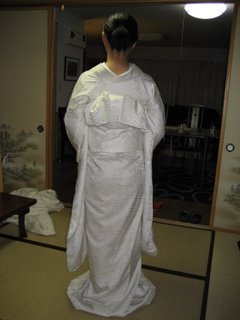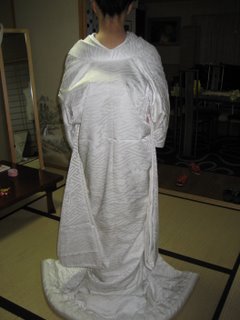
 Today, I had a very long lesson (about six hours, but not entirely non-stop) on how to hanayome, or bridal kimono.
Today, I had a very long lesson (about six hours, but not entirely non-stop) on how to hanayome, or bridal kimono.
 I practiced on my mannequin at first. When after she was done with work, Masako-san came over and I got to dress her. Working on a real person is actually much easier than working on a mannequin.
I practiced on my mannequin at first. When after she was done with work, Masako-san came over and I got to dress her. Working on a real person is actually much easier than working on a mannequin.This particular kind of hanayome is called shiromuku, since the outfit is entirely white. Some hanayome types are very colorful, with red being a very dominate colour choice, as red is considered a lucky color.
Hanayome outfits, because of the number of layers and the quality of silk, tend to be very heavy. Masako said this one wasn't too bad, maybe about 10 pounds.
Fancier or more heavily embroideried outfits can

 weight up to 20 pounds or so!
weight up to 20 pounds or so!Even an experienced kimono dresser needs an assistant in order for the hanayome to be put on as efficiently as possible.
No comments:
Post a Comment